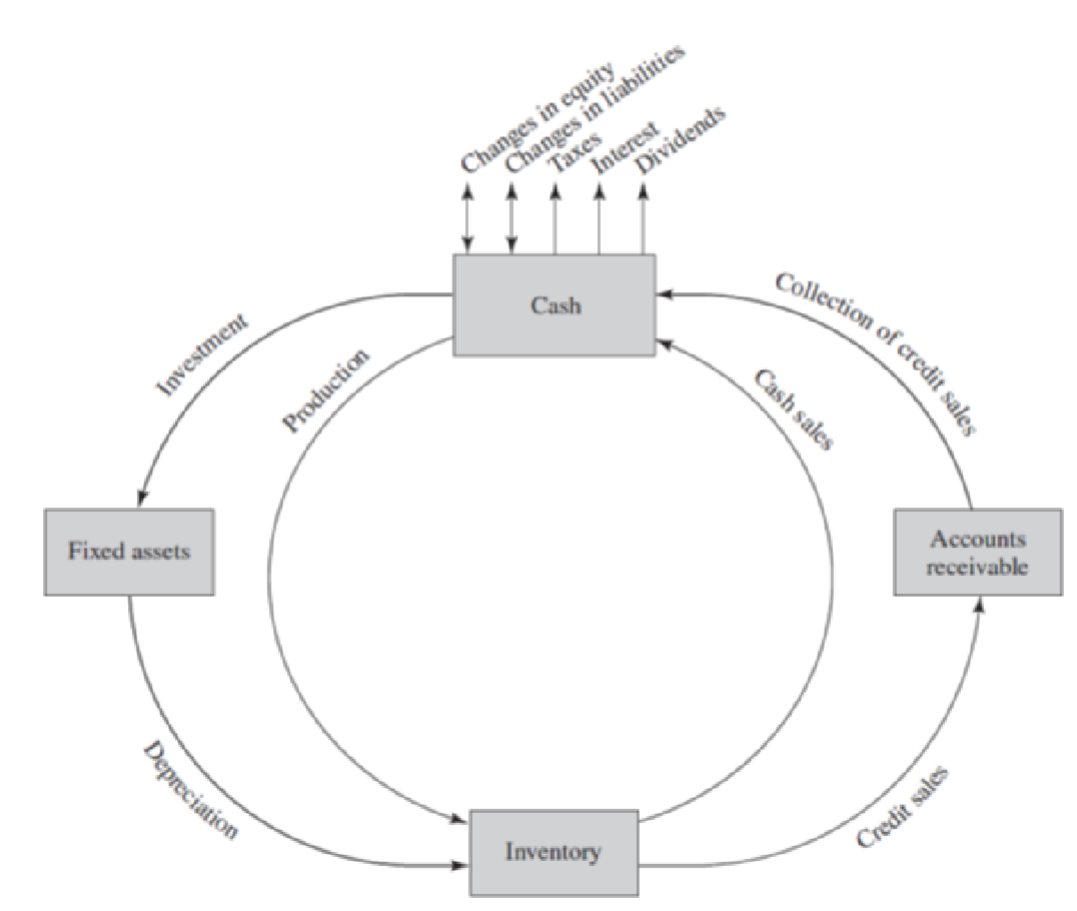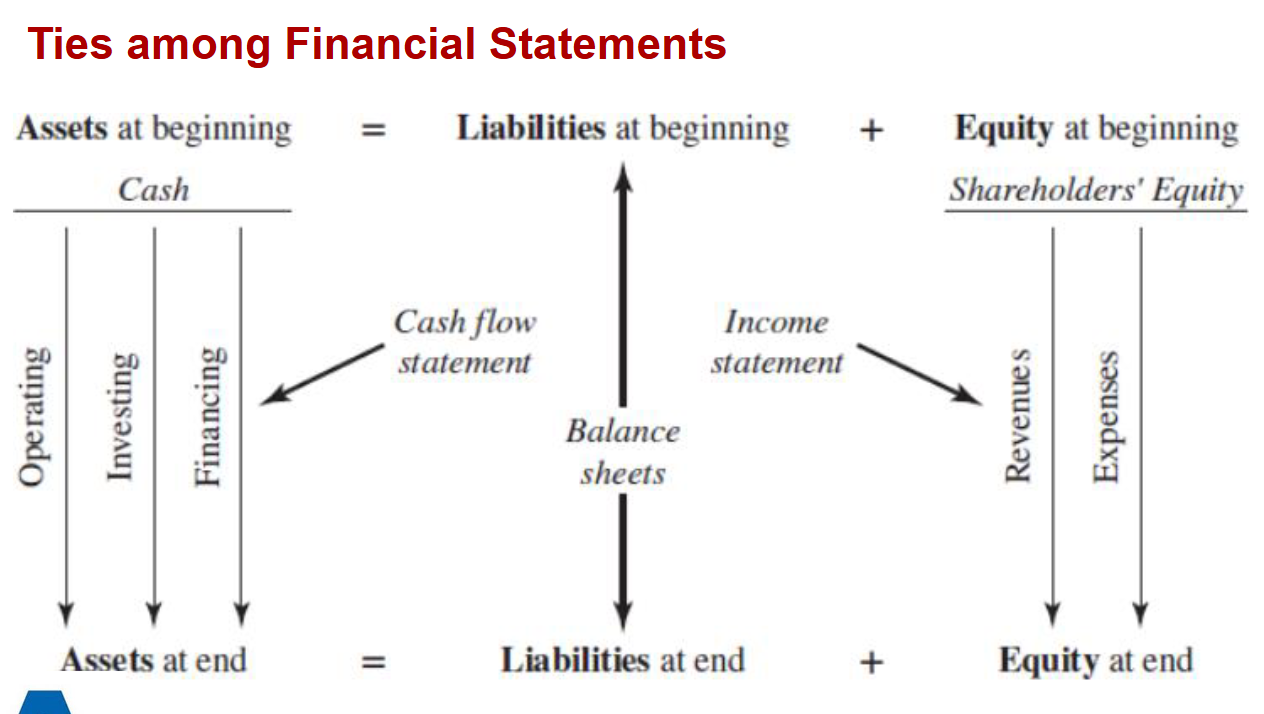Interpreting Financial Statements
1/18
There's no tags or description
Looks like no tags are added yet.
Name | Mastery | Learn | Test | Matching | Spaced |
|---|
No study sessions yet.
19 Terms
Key Points
Accounting is the scorecard of business.
Managers who understand accounting can diagnose ills and prescribe remedies.
To start we will review accounting concepts that are essential for financial management.
The material covered here should be review. You may wish to review your introductory Accounting and Introductory Finance course materials if you need a refresher.
Finance and operations are integrally connected.
• Company operations and strategy affect financing.
• Financial decisions affect company operations.
The cash flow–production cycle demonstrates this.
Where is production (operations) in this cycle?

Principles Demonstrated in the Cycle

1. Financial statements are
an important window on
reality.
2. Profits do not equal cash
flow.
6
The balance sheet is a financial snapshot.
Assets = Liabilities + Shareholders’ Equity
If the balance sheet is a snapshot, the income statement and
cash flow statement are videos.
The income statement shows how revenues and expenses
determine changes in owners’ equity over a period of time.
The cash flow statement provides details of the change in
cash balances over time.
How Financial Statements are Connected

Other Balance Sheet Points
Current assets and liabilities
• “Current” means it is expected to turn into cash within one
year.
Shareholders’ equity
• Don’t worry too much about the different categories of
equity (common stock, paid-in capital, retained earnings,
treasury stock).
• Net income (less any dividends paid) goes into retained
earnings.
The Income Statement
Basic relation: Revenues − Expenses = Net Income
Distinction between operating and nonoperating expenses
Measuring Earnings
Accrual accounting and the matching principle
Depreciation
• Straight-line versus accelerated.
Taxes
• 2 sets of books: one to report financial condition of company
to investors and the second to compute taxes.
Research and marketing
• Expense it all! (Why?)
Tax Arithmetic
Provision for income taxes on income statement
+ increase in prepaid income taxes on asset side of balance
sheet
− increase in income taxes payable and deferred income
taxes on liabilities side of balance sheet
= Taxes paid
18
Sources and Uses Statements
The income statement does not accurately show the
movement of cash.
• It includes items that are not cash flows.
• It only lists cash flows pertaining to sales during the period.
For cash flows, we need something else.
Where does a company get its cash, and where does it spend
its cash?
21

Statement of Cash Flows
Expansion and rearrangement of sources and uses
Divides cash flows into 3 categories
• Operations.
• Investing.
• Financing.
Typically reports additional categories, such as dividends,
repurchases, capital expenditures
Highlights the solvency of the firm
Cash Flow and Net Income 1
Which is the better measure of performance?
Net income includes estimates, allocations, and
approximations.
Cash flow from operations is actual cash.
Low or negative cash flow does not necessarily imply poor
performance.
Cash flow statements can record items such as AR and
employee stock options differently from sources and uses.
Market Value vs. Book Value
The financial statements are a mix of historical amounts and
mark-to-market amounts.
Book values are historical.
Market values are forward-looking.
Intangible assets not appearing in the financial statements
include patents, brand reputation, superior technology,
human capital of workforce, etc.
Fair Value Accounting
Some quirks revealed by financial crisis of 2008
Drop in market value of debt
Fair value accounting required firms to record this change as
a gain, because they were able to repurchase the debt at a
lower price than they originally issued (sold) it.
Effect reversed when market rebounded
Goodwill
Intangible on the balance sheet
Goodwill is the difference between acquisition price and the
fair value of the asset acquired.
Fair value corresponds to either the book value or the
replacement value of the target, whichever is more
appropriate.
For Polaris, how important is goodwill (see Table 1.2)?
Economic Income and Accounting Income
Realized versus unrealized income
Marketable securities are marked to market, but other assets
are not.
Imputed costs: Economic income recognizes the cost of
equity as well as the cost of debt, while accounting income
does not.
Adjusted earnings
Reported by two-thirds of companies in the S&P 500
Common adjustments
• Restructuring charges.
• Litigation expenses.
• Acquisitions.
SEC regulates use of adjusted earnings
Are adjusted earnings informative for investors or simply
an effort by managers to hide problems?
International Financial Reporting
Standards
2005, Europe adopts IFRS
140+ countries have adopted
What about Japan, China, and U.S.?
Impact of accounting scandals in the U.S.
Principles versus rules